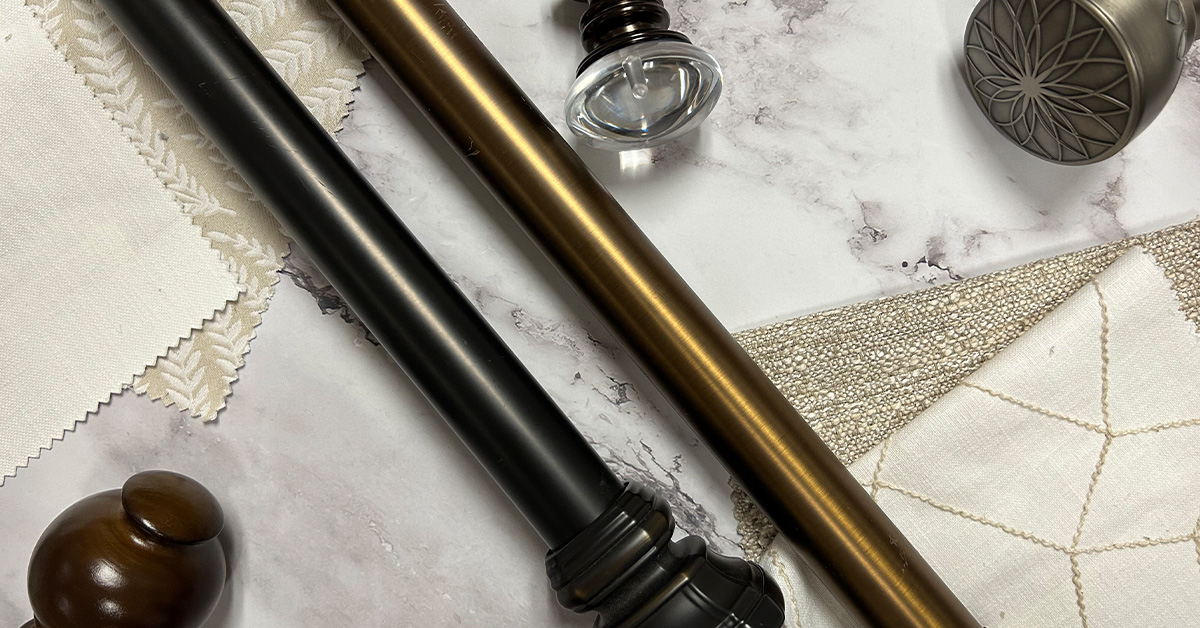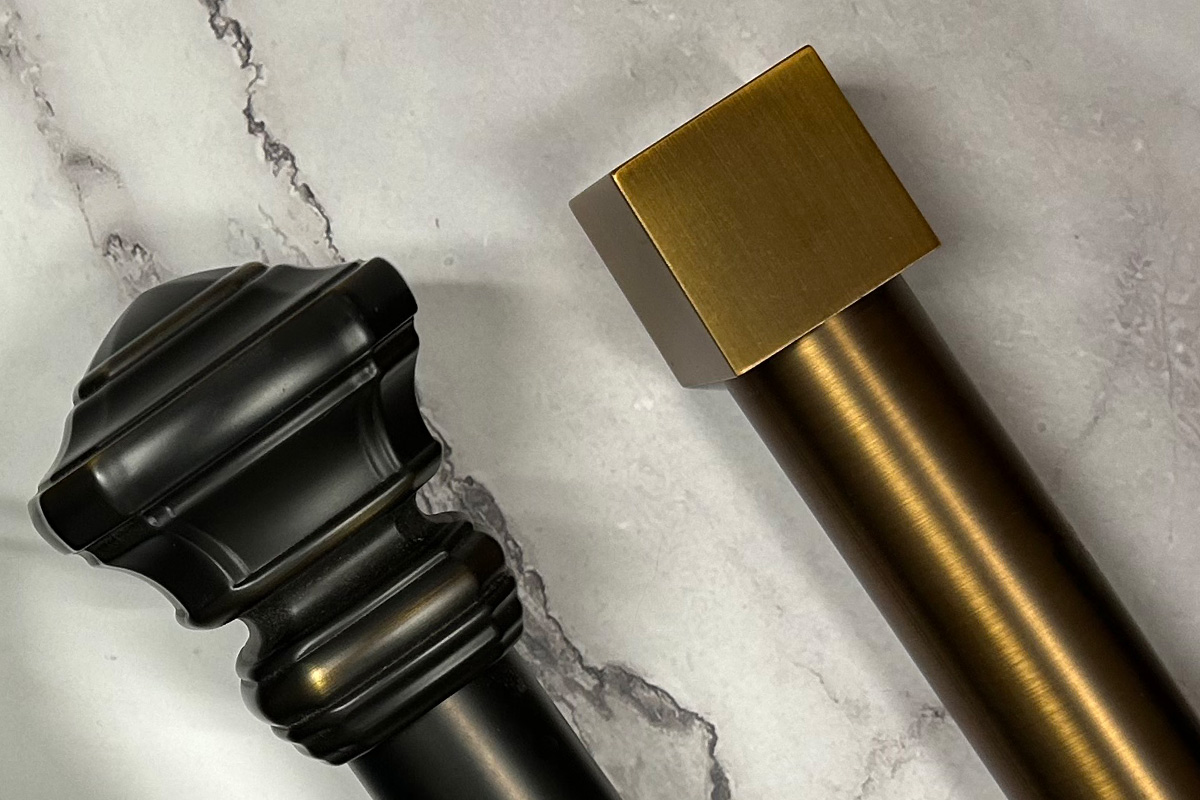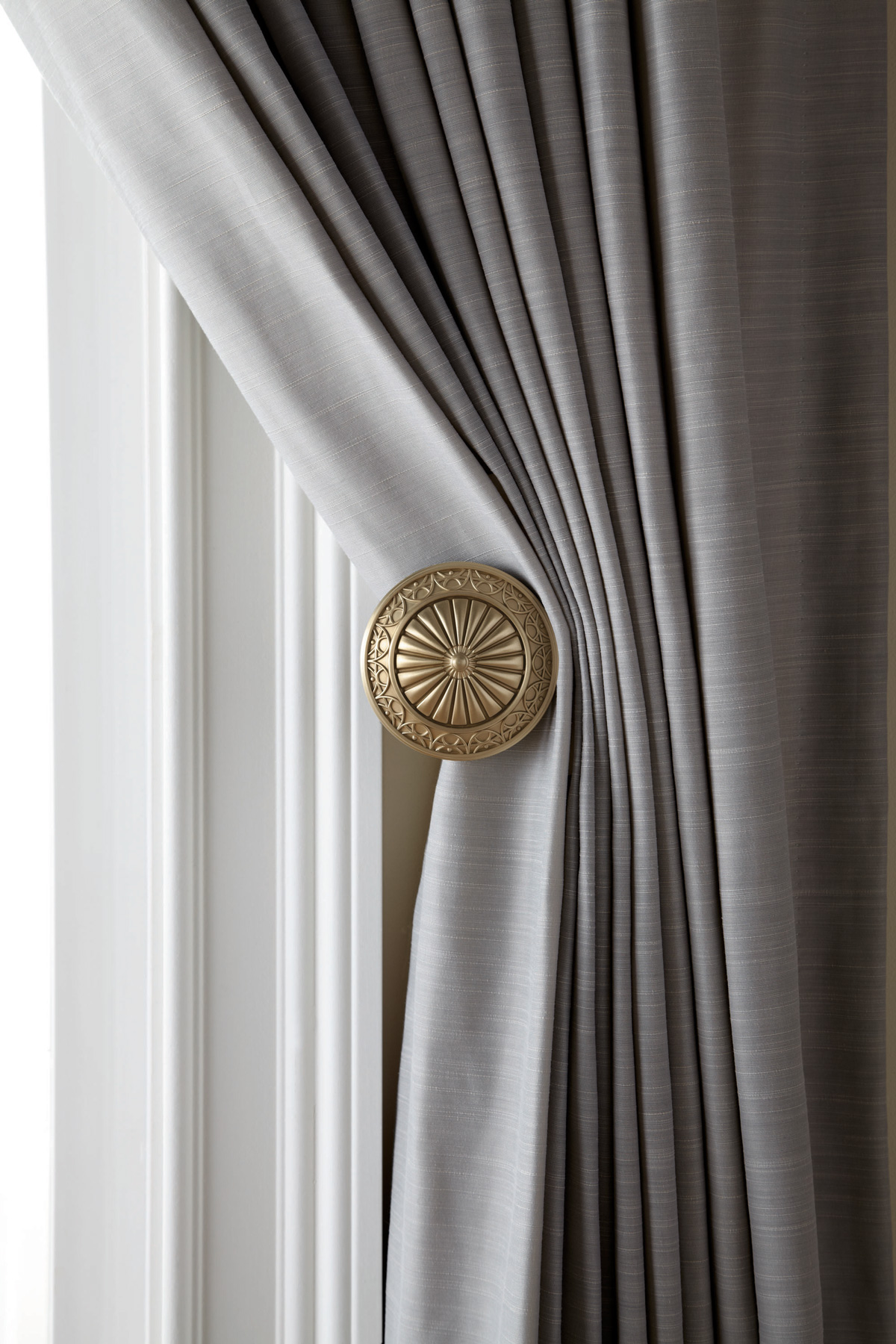
An Introduction to Drapery Hardware
Brooke Cleaver September 13, 2023
Draperies can do wonders for a home. They have the power to transform, providing privacy and light control. But there's another player in this design equation that's just as equally important: The hardware. Often overlooked, drapery hardware can significantly influence the look and feel of a room, either making or breaking a design.
While the notion of hardware might sound overwhelming, we promise it's not as formidable as it seems. Join us as we delve into the world of drapery hardware, unravel its intricacies, and explore the exciting design possibilities that await.
What is Drapery Hardware?
Drapery hardware refers to a wide range of items – including rods, brackets, rings, endcaps, and more. These components work together to ensure your drapery hangs and performs as anticipated. But they also serve another purpose: To act as a decorative frame or accent for your windows. Much like cabinet hardware, drapery hardware comes in a variety of styles, shapes, colors, and finishes so you can achieve the unique aesthetic you're after. But how do all these pieces work together, and more importantly, how do I know which ones will work best for my application? Follow along to learn about each key component and how they can aid you on your design journey.
Rods, Poles, and Tracks
When considering drapery hardware, the rod is usually the first thing that comes to mind. And for good reason. The rod plays a crucial role in your drapery's overall design and functionality. The rod is the horizontal component that sits above your window, either on the wall or ceiling, from which your drapery hangs and functions. However, it's important to note that not all rods are identical. So, before you start browsing for hardware, it's essential for you to identify which rod will work best for your space and application. Listed below are some of the most common rod types and how they're used.

Featured: Kirsch Drapery Hardware
1. Stationary Poles
The perfect solution for those who crave beauty and style. Stationary poles are primarily used as a decorative accent or accessory rather than a tool for operation. As the name suggests, stationary poles are best used with stationary treatments or heading styles that are designed to stay in place, such as those that use grommets, rings, rod pockets, ties, and tabs. Choose from a wide array of styles and finishes, ranging from wood to mixed metal, for maximum impact.
2. Tension Rods
Tension rods differ more than other kinds of rods in that they're not permanent fixtures. Unlike stationary poles or traverse rods, tension rods are designed to slip inside your window frame without the use of brackets or screws. This makes it the perfect solution for lightweight panels or sheers. Tension rods are also great for smaller projects, such as those involving doors or sidelights.
3. Traverse Rods
If you plan to open and close your treatments on a regular basis, you'll want to select a traverse rod. Traverse rods are best suited for styles that invite function, like a pleated or ripplefold™ drapery. Most traverse rods come equipped with carriers or slides that move along a hidden track. These slides attach to your drapery, usually via a pin, allowing your drapery to glide gracefully along the track. Choose from a multitude of styles and finishes, from plain to polished, for a truly customized approach that perfectly complements your personality and style preferences.
4. Motorized Rods
Sleek and modern, motorized rods are quickly becoming one of the most popular options on the market, and as homeowners continue to integrate their homes with smart technology, we expect that this type of rod will only continue to grow in popularity. Unlike a traditional traverse rod, motorized rods can be opened or closed with the flip of a switch, press of a button, or swipe of an app, offering maximum convenience.
Drapery Rings
Now that we've covered rods, it's time to move on to rings! A popular choice, rings allow for subtle sophistication and effortless charm, all while offering support to your drapery or panel. Think of rings as the link between your drapery and your pole. However, it's important to note that rings are not suitable for all heading styles. Treatments, such as ripplefolds™, grommet tops, tab tops, ties, and rod pockets, don't require the use of rings.

Photo: Courtesy of Kirsch Drapery Hardware
Finials & Endcaps
Practical, refined, and stylish: Finials and endcaps are a subtle way of adding a touch of elegance and finesse to a room. Typically used to describe the ornamental tops of skyscrapers and buildings, the term can also be used to describe the decorative bulb or piece that locks onto the end of a drapery rod. But what's the difference between a finial and an endcap? Finials are generally larger and more decorative in nature and are designed to accentuate the rod via various shapes and sizes – whereas endcaps enrich a space with understated beauty. That being said, both are great options for adding a bit of style and flair to a room.
So, what are the hard and fast rules regarding endcaps and finials? The first thing you should be aware of is space. Finials can vary significantly in size. Some can range anywhere from two inches in length to nine. Because of this, you'll want to consider your wall space when planning your design. If you're dealing with a corner or bookcase, you may have to adjust your finial size so that it doesn't interfere with surrounding objects or structures. If you're working with a minimal amount of space, you may be better off choosing a decorative endcap.
Brackets: Beauty & Brawn
Don't let the title scare you. While brackets may seem intimidating, we promise they're not as scary as they may appear. Though not every type of rod requires brackets (Cough. Cough. We're talking about you, tension rods), most require at least some form of support. And what better companion than your brackets? The brackets are the loops or rings that mount on your wall or ceiling from which your rod hangs. They're essentially the muscle behind your drapery design. Choose from a wide array of coordinating styles, finishes, and colors for a cohesive look brimming with thought and intention.
Accessories
Finally, let's discuss one of our favorite topics: Drapery accessories. If drapery hardware is akin to jewelry, you might liken the accessories to the gems. Optional yet stunning, these subtle pieces have the potential to fill your home with traces of character and charm. Allow light to seamlessly flow through your window with the help of an ornamental holdback, or move your panel in style with the assistance of a wrought iron baton. No matter what style or look you're going for, there is sure to be a beautiful accessory ready to coordinate with the rest of your proverbial outfit.

Photo: Courtesy of Kirsch Drapery Hardware
Final Thoughts
As we conclude our journey through the world of drapery hardware, remember that design is not just about aesthetics; it's about creating a space that truly reflects your personality and mood. Drapery hardware may seem like a small detail, but it carries the potential to make a big impact. So, don't be afraid to explore, experiment, and let your creativity shine. Show us some of your favorite hardware moments on Instagram and Facebook! Until next time!
Lafayette Interior Fashions is a family-owned, to-the-trade manufacturer of blinds, shades, shutters, draperies, and other custom-crafted interior fashion products. To learn more about our products, Find a local dealer near you.




